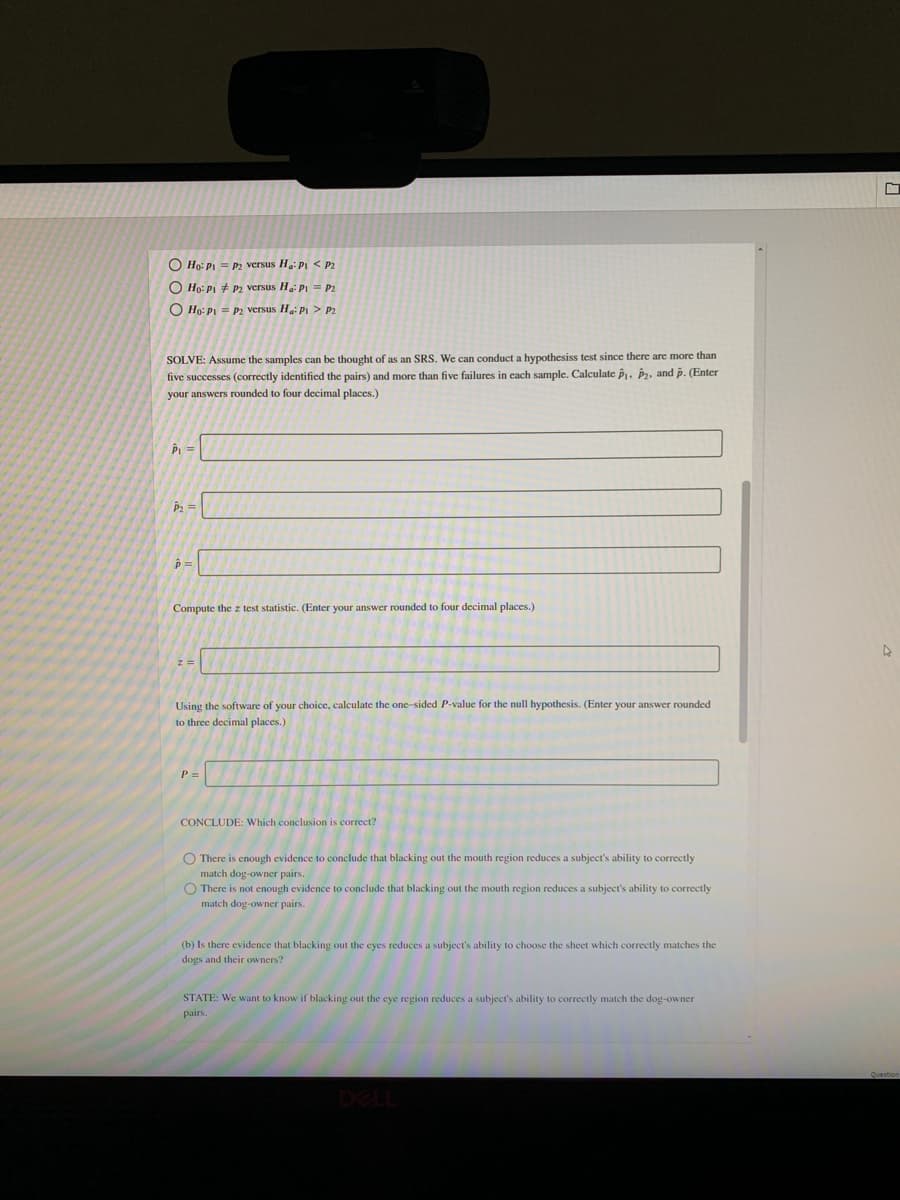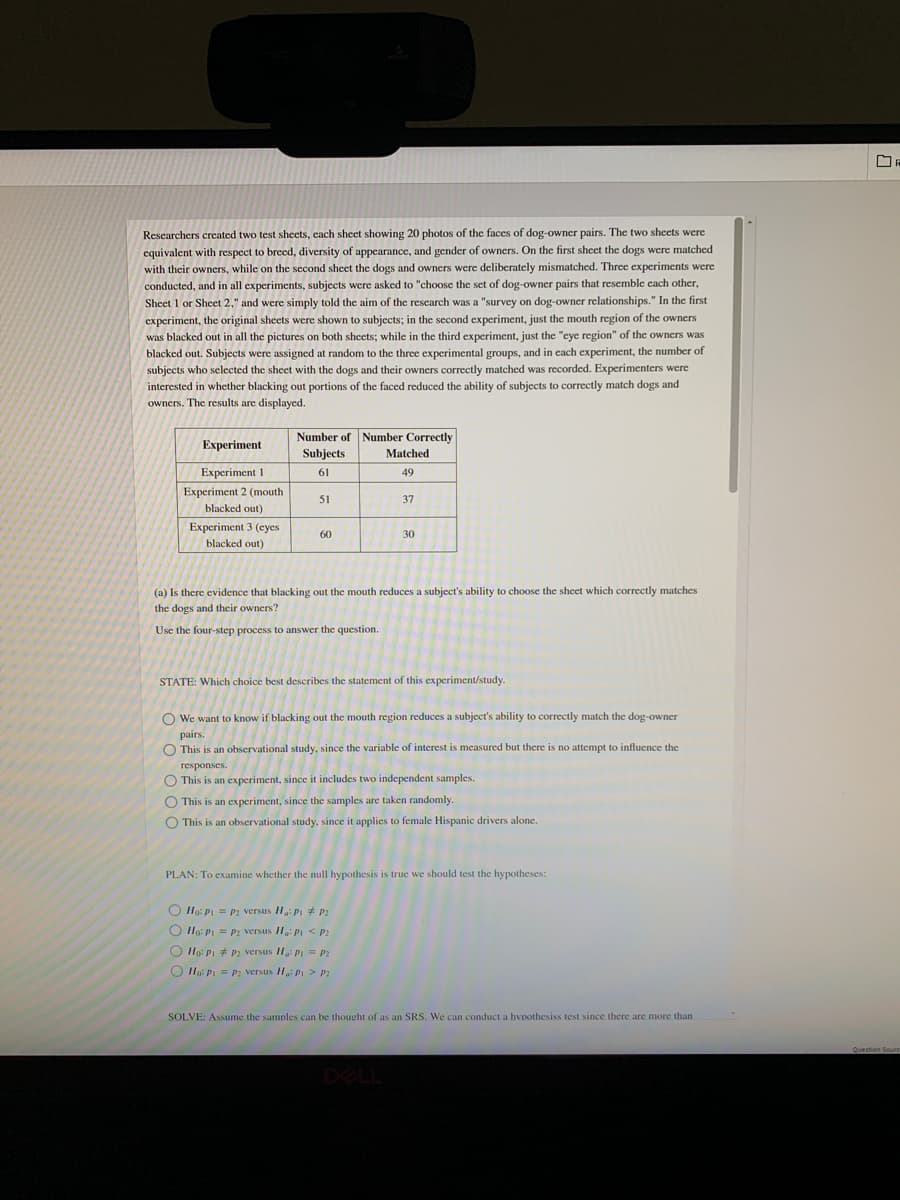O Ho: PI = P2 versus H: PI < P O Ho: PI + P2 versus H P = P2 O Ho: PI = P2 versus H Pi > P2 %3! SOLVE: Assume the samples can be thought of as an SRS. We can conduct a hypothesiss test since there are more than five successes (corrctly identified the pains) and more than five failures in cach sample. Calculate i , Þy, and p. (Enter your answers rounded to four decimal places.) Compute the z test statistic. (Enter your answer rounded to four decimal places.) Using the software of your choice, calculate the one-sided P-value for the null hypothesis. (Enter your answer rounded to three decimal places.) CONCLUDE: Which conclusion is correct? O There is enough evidence to conclude that blacking out the mouth region reduces a subject's ability to correctly match dog-owner pairs. There is not enough evidence to conclude that blacking out the mouth region reduces a subject's ability to correctly match dog-owner pairs. (b) Is there evidence that blacking out the eyes reduces a subject's ability to choose the sheet which correctly matches the dogs and their owners? STATE: We want to know if blacking out the eye region reduces a subject's ability to correctly match the dog-owner pairs.
O Ho: PI = P2 versus H: PI < P O Ho: PI + P2 versus H P = P2 O Ho: PI = P2 versus H Pi > P2 %3! SOLVE: Assume the samples can be thought of as an SRS. We can conduct a hypothesiss test since there are more than five successes (corrctly identified the pains) and more than five failures in cach sample. Calculate i , Þy, and p. (Enter your answers rounded to four decimal places.) Compute the z test statistic. (Enter your answer rounded to four decimal places.) Using the software of your choice, calculate the one-sided P-value for the null hypothesis. (Enter your answer rounded to three decimal places.) CONCLUDE: Which conclusion is correct? O There is enough evidence to conclude that blacking out the mouth region reduces a subject's ability to correctly match dog-owner pairs. There is not enough evidence to conclude that blacking out the mouth region reduces a subject's ability to correctly match dog-owner pairs. (b) Is there evidence that blacking out the eyes reduces a subject's ability to choose the sheet which correctly matches the dogs and their owners? STATE: We want to know if blacking out the eye region reduces a subject's ability to correctly match the dog-owner pairs.
Chapter8: Sequences, Series,and Probability
Section8.6: Counting Principles
Problem 74E: Lottery Powerball is a lottery game that is operated by the Multi-State Lottery Association and is...
Related questions
Topic Video
Question

Transcribed Image Text:O Ho: PI = P2 versus H: Pi < P.
O Ho: PI + P2 versus H.: PI = P2
O Ho: PI = P2 versus H: Pi > P2
SOLVE: Assume the samples can be thought of as an SRS. We can conduct a hypothesiss test since there are more than
five successes (correctly identified the pairs) and more than five failures in each sample. Calculate i. ê2, and p. (Enter
your answers rounded to four decimal places.)
PI =
P2 =
Compute the z test statistic. (Enter your answer rounded to four decimal places.)
z =
Using the software of your choice, calculate the one-sided P-value for the null hypothesis. (Enter your answer rounded
to three decimal places.)
P =
CONCLUDE: Which conclusion is correct?
O There is enough evidence to conclude that blacking out the mouth region reduces a subject's ability to correctly
match dog-owner pairs.
O There is not enough evidence to conclude that blacking out the mouth region reduces a subject's ability to correctly
match dog-owner pairs.
(b) Is there evidence that blacking out the eyes reduces a subject's ability to choose the sheet which correctly matches the
dogs and their owners?
STATE: We want to know if blacking out the eye region reduces a subject's ability to correctly match the dog-owner
pairs.

Transcribed Image Text:Researchers created two test sheets, each sheet showing 20 photos of the faces of dog-owner pairs. The two sheets were
equivalent with respect to breed, diversity of appearance, and gender of owners. On the first sheet the dogs were matched
with their owners, while on the second sheet the dogs and owners were deliberately mismatched. Three experiments were
conducted, and in all experiments, subjects were asked to "choose the set of dog-owner pairs that resemble each other,
Sheet 1 or Sheet 2," and were simply told the aim of the research was a "survey on dog-owner relationships." In the first
experiment, the original sheets were shown to subjects; in the second experiment, just the mouth region of the owners
was blacked out in all the pictures on both sheets; while in the third experiment, just the "eye region" of the owners was
blacked out. Subjects were assigned at random to the three experimental groups, and in each experiment, the number of
subjects who selected the sheet with the dogs and their owners correctly matched was recorded. Experimenters were
interested in whether blacking out portions of the faced reduced the ability of subjects to correctly match dogs and
owners. The results are displayed.
Number of
Number Correctly
Experiment
Subjects
Matched
Experiment 1
61
49
Experiment 2 (mouth
51
37
blacked out)
Experiment 3 (eyes
blacked out)
60
30
(a) Is there evidence that blacking out the mouth reduces a subject's ability to choose the sheet which correctly matches
the dogs and their owners?
Use the four-step process to answer the question.
STATE: Which choice best describes the statement of this experiment/study.
O We want to know if blacking out the mouth region reduces a subject's ability to correctly match the dog-owner
pairs.
O This is an observational study, since the variable of interest is measured but there is no attempt to influence the
responses.
O This is an experiment, since it includes two independent samples.
O This is an experiment, since the samples are taken randomly.
O This is an observational study, since it applies to female Hispanic drivers alone.
PLAN: To examine whether the null hypothesis is true we should test the hypotheses:
O Ho: PI = P2 versus H.: Pi P2
O Ilo: PI = P, versus H: PI < P2
Ho: PI + P2 versus 1: PI = P2
O Ho: Pi = p: versus H: Pi > P2
SOLVE: Assume the samples can be thought of as an SRS. We can conduct a hvpothesiss test since there are more than
Question Sourc
DEL
Expert Solution
This question has been solved!
Explore an expertly crafted, step-by-step solution for a thorough understanding of key concepts.
This is a popular solution!
Trending now
This is a popular solution!
Step by step
Solved in 2 steps with 11 images

Knowledge Booster
Learn more about
Need a deep-dive on the concept behind this application? Look no further. Learn more about this topic, statistics and related others by exploring similar questions and additional content below.Recommended textbooks for you



Algebra & Trigonometry with Analytic Geometry
Algebra
ISBN:
9781133382119
Author:
Swokowski
Publisher:
Cengage



Algebra & Trigonometry with Analytic Geometry
Algebra
ISBN:
9781133382119
Author:
Swokowski
Publisher:
Cengage

Holt Mcdougal Larson Pre-algebra: Student Edition…
Algebra
ISBN:
9780547587776
Author:
HOLT MCDOUGAL
Publisher:
HOLT MCDOUGAL